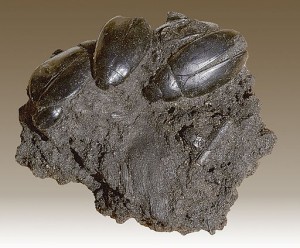
For tens of thousands of years, natural asphalt has oozed from the earth in this part of California. Crude oil seeps up along the 6th Street Fault from the Salt Lake Oil Field, forming pools topside in several locations in the park. The oil becomes sticky asphalt as lighter fractions of petroleum evaporate or biodegrade, though methane gas emerges in uneven bursts and makes the pools look like they’re boiling.
This California tar has preserved the bones of many prehistoric creatures and pieces of plant life, giant and tiny, mostly from the last glacial period. Paleontologists have excavated saber-tooth cats, dire wolves, giant ground sloths, and a nearly intact mammoth nicknamed Zed. When covered with leaves, dirt, and water, the land became a snare for any animal that wandered too close. Predators then approached the dying prey in hopes of an easy meal, only to become stuck themselves. It was a cruel cycle, so Los Angeles fenced it all in to save today’s wildlife from meeting the same fate. A 2006 dig unearthed six dire wolves, and archaeologists were then able to confidently infer that the creatures hunted in packs like their modern relatives. The on-site George C. Page Museum is dedicated to researching and displaying the animals that have died in the Los Angeles tar.
One lone human specimen has emerged from the La Brea Tar Pits, a partial female skeleton dubbed the La Brea Woman. The remains of the roughly 25-year-old female were first discovered in 1914, and date back around 10,000 years.
Sometimes black tar trickles onto the streets and flowerbeds, so at least one a week the city has to clean and drain the sewers beneath the roads. Playing host to a prehistoric landmark isn’t easy. When I lived out in Los Angeles I rode my bike past the tar pits every day, and I always caught a whiff of fresh asphalt or rotten eggs. It took me a while to realize it was the tar pits, not some nearby construction.
Check out this crash course in fossil excavation from the official La Brea Tar Pits & Museum website:
Latest posts by Kathryn Doers (see all)
- Summer Friday Blog: Wizard World Comic Con in Chicago - August 14, 2015
- Summer Friday Blog: La Brea Tar Pits in the Heart of Los Angeles - August 7, 2015
- Summer Friday Blog: Journey into Outer Space for the Delta Aquarid Meteor Shower - July 24, 2015
